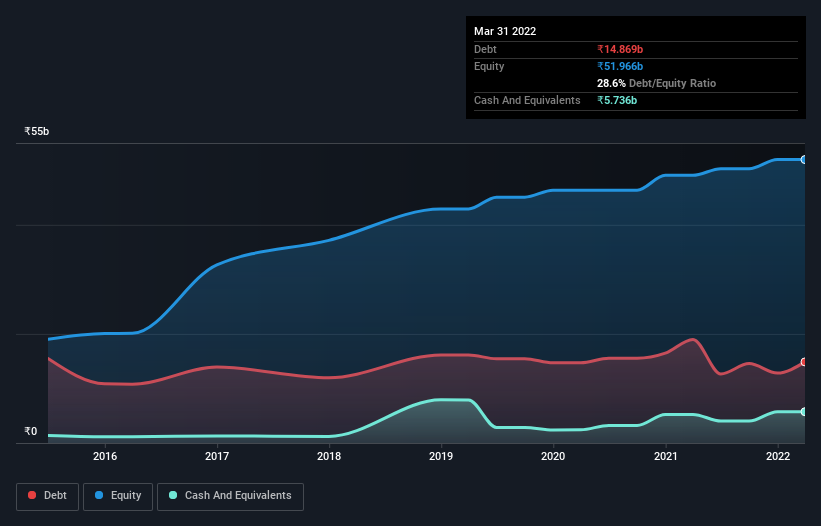- India
- /
- Auto Components
- /
- NSEI:CIEINDIA
Does Mahindra CIE Automotive (NSE:MAHINDCIE) Have A Healthy Balance Sheet?

Warren Buffett famously said, 'Volatility is far from synonymous with risk.' When we think about how risky a company is, we always like to look at its use of debt, since debt overload can lead to ruin. Importantly, Mahindra CIE Automotive Limited (NSE:MAHINDCIE) does carry debt. But should shareholders be worried about its use of debt?
Why Does Debt Bring Risk?
Debt and other liabilities become risky for a business when it cannot easily fulfill those obligations, either with free cash flow or by raising capital at an attractive price. In the worst case scenario, a company can go bankrupt if it cannot pay its creditors. While that is not too common, we often do see indebted companies permanently diluting shareholders because lenders force them to raise capital at a distressed price. Of course, debt can be an important tool in businesses, particularly capital heavy businesses. When we think about a company's use of debt, we first look at cash and debt together.
View our latest analysis for Mahindra CIE Automotive
What Is Mahindra CIE Automotive's Net Debt?
As you can see below, Mahindra CIE Automotive had ₹14.9b of debt at December 2021, down from ₹19.0b a year prior. However, it does have ₹5.74b in cash offsetting this, leading to net debt of about ₹9.13b.

How Strong Is Mahindra CIE Automotive's Balance Sheet?
The latest balance sheet data shows that Mahindra CIE Automotive had liabilities of ₹31.4b due within a year, and liabilities of ₹16.2b falling due after that. On the other hand, it had cash of ₹5.74b and ₹8.22b worth of receivables due within a year. So its liabilities outweigh the sum of its cash and (near-term) receivables by ₹33.6b.
Mahindra CIE Automotive has a market capitalization of ₹84.0b, so it could very likely raise cash to ameliorate its balance sheet, if the need arose. But it's clear that we should definitely closely examine whether it can manage its debt without dilution.
We use two main ratios to inform us about debt levels relative to earnings. The first is net debt divided by earnings before interest, tax, depreciation, and amortization (EBITDA), while the second is how many times its earnings before interest and tax (EBIT) covers its interest expense (or its interest cover, for short). The advantage of this approach is that we take into account both the absolute quantum of debt (with net debt to EBITDA) and the actual interest expenses associated with that debt (with its interest cover ratio).
Mahindra CIE Automotive has a low net debt to EBITDA ratio of only 0.89. And its EBIT covers its interest expense a whopping 18.8 times over. So you could argue it is no more threatened by its debt than an elephant is by a mouse. Better yet, Mahindra CIE Automotive grew its EBIT by 115% last year, which is an impressive improvement. That boost will make it even easier to pay down debt going forward. The balance sheet is clearly the area to focus on when you are analysing debt. But it is future earnings, more than anything, that will determine Mahindra CIE Automotive's ability to maintain a healthy balance sheet going forward. So if you want to see what the professionals think, you might find this free report on analyst profit forecasts to be interesting.
But our final consideration is also important, because a company cannot pay debt with paper profits; it needs cold hard cash. So we always check how much of that EBIT is translated into free cash flow. Over the most recent three years, Mahindra CIE Automotive recorded free cash flow worth 73% of its EBIT, which is around normal, given free cash flow excludes interest and tax. This free cash flow puts the company in a good position to pay down debt, when appropriate.
Our View
Happily, Mahindra CIE Automotive's impressive interest cover implies it has the upper hand on its debt. And the good news does not stop there, as its EBIT growth rate also supports that impression! Zooming out, Mahindra CIE Automotive seems to use debt quite reasonably; and that gets the nod from us. While debt does bring risk, when used wisely it can also bring a higher return on equity. When analysing debt levels, the balance sheet is the obvious place to start. But ultimately, every company can contain risks that exist outside of the balance sheet. Be aware that Mahindra CIE Automotive is showing 1 warning sign in our investment analysis , you should know about...
At the end of the day, it's often better to focus on companies that are free from net debt. You can access our special list of such companies (all with a track record of profit growth). It's free.
New: AI Stock Screener & Alerts
Our new AI Stock Screener scans the market every day to uncover opportunities.
• Dividend Powerhouses (3%+ Yield)
• Undervalued Small Caps with Insider Buying
• High growth Tech and AI Companies
Or build your own from over 50 metrics.
Have feedback on this article? Concerned about the content? Get in touch with us directly. Alternatively, email editorial-team (at) simplywallst.com.
This article by Simply Wall St is general in nature. We provide commentary based on historical data and analyst forecasts only using an unbiased methodology and our articles are not intended to be financial advice. It does not constitute a recommendation to buy or sell any stock, and does not take account of your objectives, or your financial situation. We aim to bring you long-term focused analysis driven by fundamental data. Note that our analysis may not factor in the latest price-sensitive company announcements or qualitative material. Simply Wall St has no position in any stocks mentioned.
About NSEI:CIEINDIA
CIE Automotive India
Produces and sells automotive components to original equipment manufacturers and other customers in India, Europe, and internationally.
Flawless balance sheet and good value.

